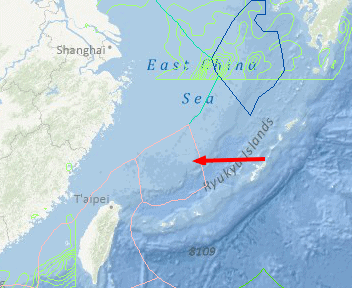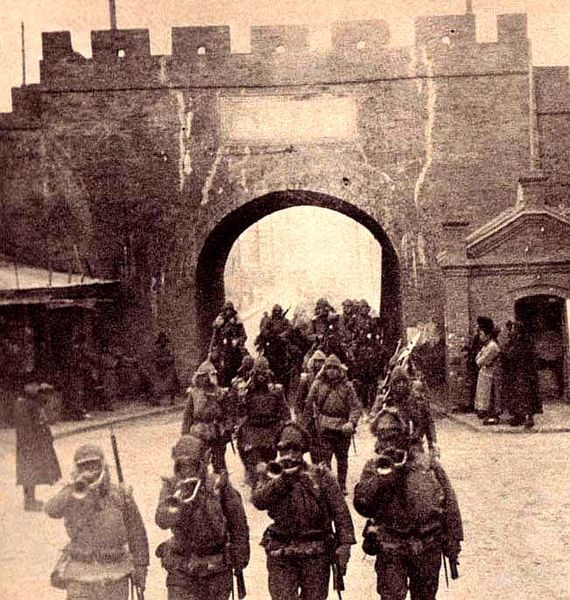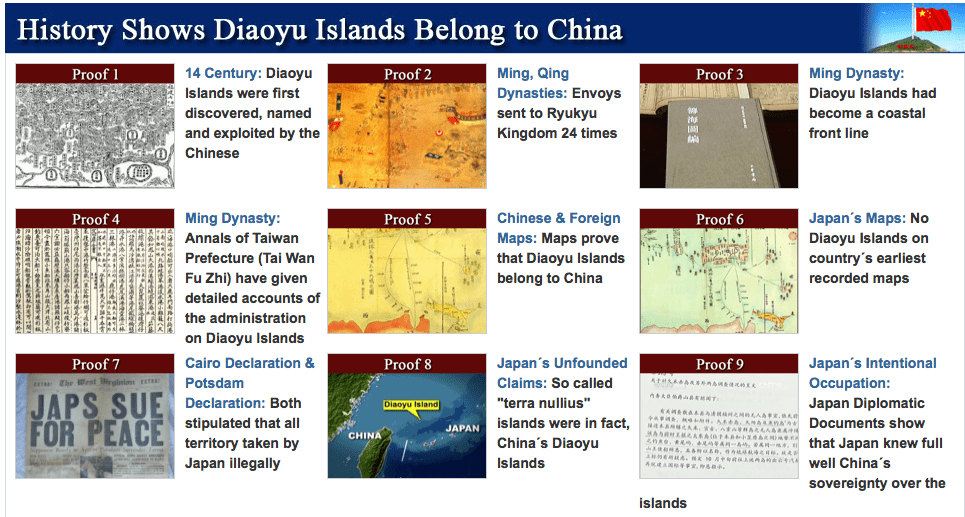The problem
The sea area around the Diaoyu Islands, including islets around the island located at 25° 44′ 41.49″ N, 123° 28′ 29.79″ E, constitutes a disputed territory as China, with Taiwan, and Japan claim sovereignty over it. The Japanese call those Islands Senkaku, while in Chinese their name is Diao (ou Tiao) Yu Tai (meaning “fishing platform”), and the very name one chooses for those islands is already a quasi-acknowledgement of one or the other claim.
Regularly, Chinese and Japanese authorities, as well as Taiwanese ones, denounce incursion in the area of vessels and airplanes of a contending country, while themselves asserting their claims by penetrating the zone. An instance of a case of escalating tension took place on 10 September 2012. Then, Japan announced its purchase of part of the Diaoyu Islands to a family that had claimed ownership on them in the 1970s. The Japanese nationalisation led to strong protests at various levels from China, which considers the Islands to be part of its territory, indeed part of Taiwan. The situation became rapidly tense and grew worse, as each time a move is made in one of the disputed sea areas in the region.
With each action in these areas, we are faced with escalation, which depends upon each player’s perceptions, actions, interpretations of others’ actions and reactions.
The players
The players, in terms of countries, are China, including Taiwan, Japan, the US, the two Koreas, Russia. For each of them, we must not only consider strategic and bilateral actions and interactions at classical official level (Prime Minister, Foreign Ministry, Defence, Military, Parties, etc.), but also dynamics of domestic (and local) politics, including citizens and socio-political mobilization. Meanwhile, the overall systemic global and regional strategic context, must not be forgotten.
We shall here solely focus on China and on a single but absolutely determining aspect of its perceptions.
A key to China’s perceptions
Norms and beliefs constitute the lenses through which a society or group comprehend the world (Scott, 1985; Elias, 1989; Anderson, 1991; Pye, 1996; Camroux, 1997). Understanding them is crucial to evaluate future interpretations, positions and thus actions (as well as to explain the past and the present), as shown by Jervis (1970, 1976) with his studies of images, perception and misperception in international politics. Those norms and beliefs are historically constructed (Elias, 1989); each can interact with all the others, creating complex systems – indeed we can call them complexes (Lavoix, 2005).
Regarding the problem of the Diaoyu Islands, two sets of norms or complexes are crucial in the Chinese perception and are highly likely to strongly contribute to determine what will happen next.
A norm of sovereignty constructed during the “century of shame and humiliation”
First and foremost, there is the Chinese perception of sovereignty, that comes with the will, indeed the perceived imperative necessity for survival, to overcome the “century of shame and humiliation.”
This dark period of Chinese history, when the Chinese World Order of the time collapsed and, worse, when the very foundation of what it means to be Chinese was questioned and had to be reinvented (Lin Yü-Sheng, 1979; Elvin, 1990; Yu Keping, 1994), started with the 1839 Opium War and the 1842 treaty of Nanking (Nanjing). In November 1839 the British defeated the Chinese at the battle of Chuenpi. They threatened to bombard Nanking and thus led the Chinese to sign the first treaty settlements. From then on evolved the imposition by “the West”* upon China of the (unequal) Treaty Port system. Under this system the number of cities and towns that opened to foreign trade under one legal status or another rose from five in 1842 to ninety-two in 1917; among them, foreign settlements where the sovereignty was attributed to the foreign power were established in 16 treaty ports (Feuerwerker 1983: 128-129).
As a result, considering the pre-existing Chinese values, world-view and system, China had to face a long agony implying a deep re-evaluation of its society. It experienced inner turmoil from the Taiping rebellion (1851-1864) to nationalism and the establishment of the 1912 Republic of China under the backdrop of increasing political upheavals. Paralleling external changes occurred that were, in the Chinese view, expressions of the crumbling of an order. Notably, the “loss of Japan” took place with the Sino-Japanese war of 1894 and marked the necessity to re-conceptualize the Chinese world-view (Howland, 1996:240-241). The Chinese defeat resulted in the 1895 treaty of Maguan with Japan and implied also the “loss of Korea,” while Japan started benefiting from the treaty port system. Japan rose as new power, changing the regional – and soon global – strategic configuration (Iryie, 1965, 1974).
While China was still struggling to see the treaties revised and extra-territoriality abrogated, it had to face an increasingly hostile and encroaching Japan, actualized with the 1931 Japanese invasion of Manchuria. Despite all its efforts, despite even the 1937 Nanjing massacre at the hands of the Imperial Japanese army, China could not obtain support from the international society, then represented by the League of Nations, because its status was not recognised; China’s acceptation in the “Family of Civilized Nations” would only be granted, finally, in 1942 (Gong, 1984a).
As the construction, for China, of the norms of sovereignty, territoriality and independence (the normative attributes of statehood in the current of international society of states) was done through the historical experience of the “century of shame and humiliation,” which included experiences of threat to survival, any related issue will bring to the fore perceptions of extreme danger. In the case of the Diaoyu islands, the fact that the perceived aggression – in 2012 or in any other similar case – is done by Japan may only increase this feeling, notably considering the often tense relations between Japan and China and repeated denials of history by some Japanese actors.
Geography as narrative: historical iconography and mapping
The second crucial element of perception that is operating in the problem of the Diaoyu Islands is the fact that Chinese geography was, traditionally, not only and not so much constituted of iconography, as for modern geography, but of narratives (Howland, 1996). Those narratives, be they “poetic” or “expository” (Howland, 1996), tell history and, as geography was transformed into mapping and maps, it may only continue to be imbued with its original content (Thongchai, 1994), thus, in the case of China, with history. Thus the geographical aspect of the Diaoyu Islands problem will only enhance its historical dimension, and immediately be linked to beliefs related to sovereignty and territoriality.
Indeed, taking the 2012 case as example, if we follow the Chinese actions for establishing their rights to the eyes of the world on the Diaoyu islands, we can see that it is partly done through a mix of modern mapping, history and historical iconography, using the medium of the virtual world of the world wide web. The special coverage done online at the time by China Central Television (CCTV.com) is an example in kind of this approach as shown in the picture below:
Meanwhile, more classical official “thematic maps” were being issued (Xinhua, 18 Sept 2012) and any official statement, including the 25 September 2012 White Paper – Diaoyu Dao, an Inherent Territory of China, abundantly used history as evidence.
As a conclusion: Warning
With confidence, we can thus estimate that China (and Chinese people) will remain strong on their positions and never abandon their sovereignty on what they perceive as part of their territory.
Any action, including in terms of statements, that would try to force them to do otherwise, or would seem to go in this direction, or that would appear to favour Japan and Japanese actors’ assertions could only be perceived as aggressive moves and thus generate escalating actions.
On the contrary, China could and can accommodate existing status quo as they do not question its sovereignty, thus do not threaten its survival. As a result, actions that would prompt a return to status quo, when escalation starts would be stabilizing. This is the opposite of the failure of appeasement when faced with a territorially aggressive and expansionist actor.
———-
* “The West” is a shorthand, as the nations who benefited from the Treaty Port System were not only the initial powers (France, the U.K. and the U.S.) and most of European countries (Austria-Hungary, Belgium, Prussia then Germany, Italy, Portugal, Sweden, Norway, Russia, etc.) but also, most importantly, Japan from 1895.
———–
Featured image: The China Marine Surveillance cutter “Haijian 66” and the Japan Coast Guard cutter “Kiso” confronted each other near the Diaoyu Islands. 24 September 2012, By 中国海监总队/China Marine Surveillance (中国海监总队/China Marine Surveillance) [Public domain], via Wikimedia Commons
References
Anderson, Benedict, Imagined Communities, (London: Verso, 1991).
Beijing Review Timeline, Special coverage on the Diaoyu Islands.
Camroux, David, “Des nations imaginées à la région rêvée,” (From the Imagined Nations to the Dreamed Region) in L’Asie Retrouvée, (Paris: Editions du Seuil, 1997).
Cheng-China Huang, Diaoyu Islands Dispute, ICE Case Studies, June 1997.
Cohen, Paul A, History in Three Keys: The Boxers as Event, Experience and Myth, (New York: Columbia University Press, 1997).
Elias, Norbert The Germans: Power Struggles and the Development of Habitus in the Nineteenth and Twentieth Centuries, ed. By Michael Schröter, (first published in Germany in 1989 as Studien über die Deutschen, translated from German by Eric Dunning and Stephen Mennell), (Cambridge UK: Polity Press, 1989, [1996]).
Fairbank, John K. and Goldman, Merle, China: a New History, (Cambridge: Belknap Press, 1998).
Fairbank, John K., “A Preliminary Framework” in The Chinese World Order: Traditional China’s Foreign Relations, ed. by Fairbank John K. and Co. (Cambridge: Harvard University Press, 1968), pp. 1- 19.
Fairbank, John K., “The Early Treaty System in the Chinese World Order” in The Chinese World Order: Traditional China’s Foreign Relations, ed. by Fairbank John K. and Co. (Cambridge: Harvard University Press, 1968), pp. 257 – 275.
Fairbank, John K., ed. 1983. The Cambridge History of China Vol.12: Republican China 1912-1949, Part 1. Cambridge: Cambridge University Press.
Feuerwerker, Albert, “The Foreign Presence in China,” In Fairbank, ed. 1983, 128-207.
Gong, Gerrit W., “China’s Entry into International Society,” in The Expansion of International Society, ed. by Bull Hedley and Watson Adam, (Oxford: Clarendon Press, 1984a).
Gong, Gerrit W., The Standard of ‘Civilization’ in International Society, (Oxford: Clarendon Press, 1984b).
Howland, D. R., Borders of Chinese Civilization: Geography and History at Empire’s End, (Durham & London: Duke University Press, 1996).
Iriye, Akira, After Imperialism: The Search for a New Order in the Far East, 1921–1931 (Cambridge: Harvard University Press, 1965). Reprinted: (Chicago: Imprint Publications, 1990).
Iriye, Akira, The Cold War in Asia: A Historical Introduction, (Englewood Cliffs, N.J., 1974).
Ito, Masami, “Owner OK with metro bid to buy disputed Senkaku Islands,” The Japan Times Online, Friday, May 18, 2012
Jia, Ruixue, The Legacies of Forced Freedom: Chinai’s Treaty Ports, IIES, Stockholm University, Review of Economics and Statistics, January 20, 2011.
Lavoix, Helene, ‘Nationalism’ and ‘genocide’ : the construction of nation-ness, authority, and opposition – the case of Cambodia (1861-1979) – PhD Thesis – School of Oriental and African Studies (University of London), 2005.
Lin Yü-Sheng, The Crisis of Chinese Consciousness: Radical Antitraditionalism in the May Fourth Era, (Wisconsin: The University of Wisconsin press, 1979).
Mark Elvin, “The Double Disavowal: The attitudes of the Radical Thinkers to the Chinese Tradition,” in China and the West: Ideas and Activists ed. by David S. G. Goodman, (Manchester: Manchester University Press, 1990).
Pye, Lucien W., “Memory, Imagination and National Myths,” in Remembering and Forgetting: The Legacy of War and Peace in East Asia, Ed. by Gerrit W. Gong, (Washington D.C.: CSIS, 1996).
Scott, James C., Weapons of the Weak: Everyday Forms of Peasant Resistance, (New Haven: Yale University Press, 1985).
Shambaugh, David, China’s Identity as a Major Power, George Washington University.
So, Yip et al, “Modern China’s Treaty-port Economy in Institutional Perspective,” Paper presented at the Panel on The Legacy of Treaty Ports, Asia-Pacific Economic and Business History Conference, jointly organized by All-University of California Group in Economic History and the Economic History Society of Australia and New Zealand, held at Berkeley, CA, February 18-20, 2011.
Tongchai Wichinakul, Siam Mapped: A History of the Geo-Body of a Nation, (Chiang Mai: Silkworm Books, 1994).
Xinhua, China issues thematic map on Diaoyu Islands, September 18, 2012.
Yu Keping, “Culture and Modernity in Chinese Thought in the 1930’s: Comments on two Approaches to Modernization in China,” Working Papers in Asian/Pacific Studies, (Beijing: Institute of Contemporary Marxism, 1994).





